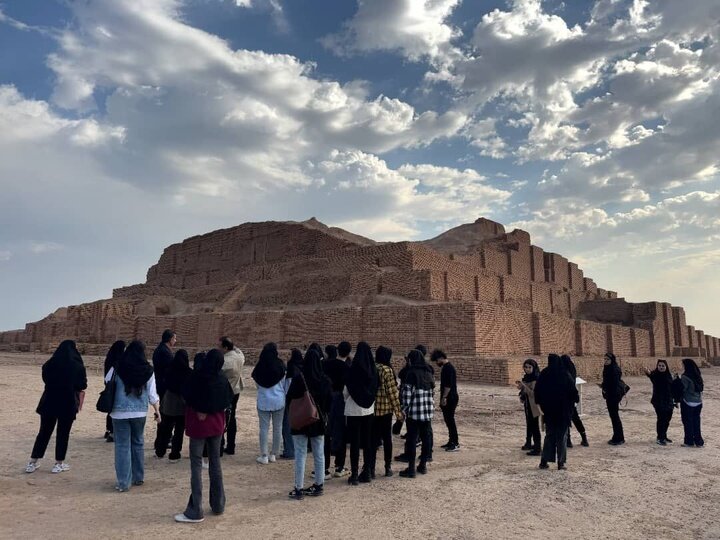Tchogha Zanbil’s landscape architecture examined by urban students

TEHRAN – UNESCO-listed Tchogha Zanbil has recently hosted an on-site workshop dedicated to landscape architecture and phenomenological interpretation of the magnificent ziggurat, which is located in Khuzestan province, southwest Iran.
A number of architecture students from Shahid Chamran University take part in the workshop organized in collaboration with the World Heritage Base of Tchogha Zanbil and Haft Tappeh and the Architecture Department of Shahid Chamran University of Ahvaz, said Atefeh Rashnoei, director of the World Heritage Base, on Saturday.
During the workshop, students also visited the research and support sections dedicated to the preservation and maintenance of this globally significant site, Rashnoei said.
She emphasized the dual responsibility of World Heritage sites, saying “It requires not only to preserve and safeguard cultural treasures but also to serve as educational hubs.”
“These sites play a leading role in multidisciplinary research and education, promoting awareness among students and the broader community.”
“The World Heritage Base of Tchogha Zanbil and Haft Tappeh, with its strong research and operational capabilities, offers significant educational opportunities. We invite all universities in the province to collaborate with us in holding joint educational workshops, fostering synergy, and sharing interdisciplinary knowledge,” Rashnoei added.
A window into ancient Elamite civilization
Tchogha Zanbil, also known as the Ziggurat of Dur-Untash, is one of the earliest UNESCO-listed sites in Iran. Constructed around 1250 BC during the Elamite era, the site stands as a testament to the architectural brilliance of its time. Despite its global recognition, Rashnoei emphasized that only 10% of the vast ancient city has been excavated so far, leaving much of its history buried.
The city of Dur-Untash, where Tchogha Zanbil is located, was meticulously designed to align with natural phenomena, including the angles of sunlight, sunrise, and sunset, as well as the cardinal directions. The site features sophisticated water purification and distribution systems, hierarchical urban planning, and proportional architectural designs that reflect the ingenuity of its creators.
Glimpses of Haft-Tappeh and Tchogha Zanbil
Haft-Tappeh (literary meaning “Seven Mounds”) is located 15 kilometers to the south of the ancient city of Susa, itself a highly significant archeological site in southwest Iran.
Early excavations in Haft-Tappeh conducted by the late Iranian archaeologist Dr. Ezzatollah Negahban yielded a large number of petroglyphs bearing cuneiform inscriptions in Akkadian, belonging to Elamite kings. The petroglyphs contain information on the religious beliefs, trading methods, and the political, cultural, and social relations of the time.
A topmost tourist destination in Khuzestan province, the magnificent ruins of Tchogha Zanbil (Choghazanbil) is considered by many the finest surviving example of Elamite architecture in the globe. It was made a UNESCO site in 1979. Its construction started in c. 1250 BC upon the order of the Elamite king Untash-Napirisha (1275-1240 BC) as the religious center of Elam dedicated to the Elamite divinities Inshushinak and Napirisha.
As mentioned by the UN cultural body, Tchogha Zanbil is the largest ziggurat outside of Mesopotamia and the best preserved of this type of stepped pyramidal monument. Tchogha Zanbil was excavated in six seasons between 1951 and 1961 by Roman Ghirshman, a Russian-born French archeologist who specialized in ancient Iran.
AM
Leave a Comment